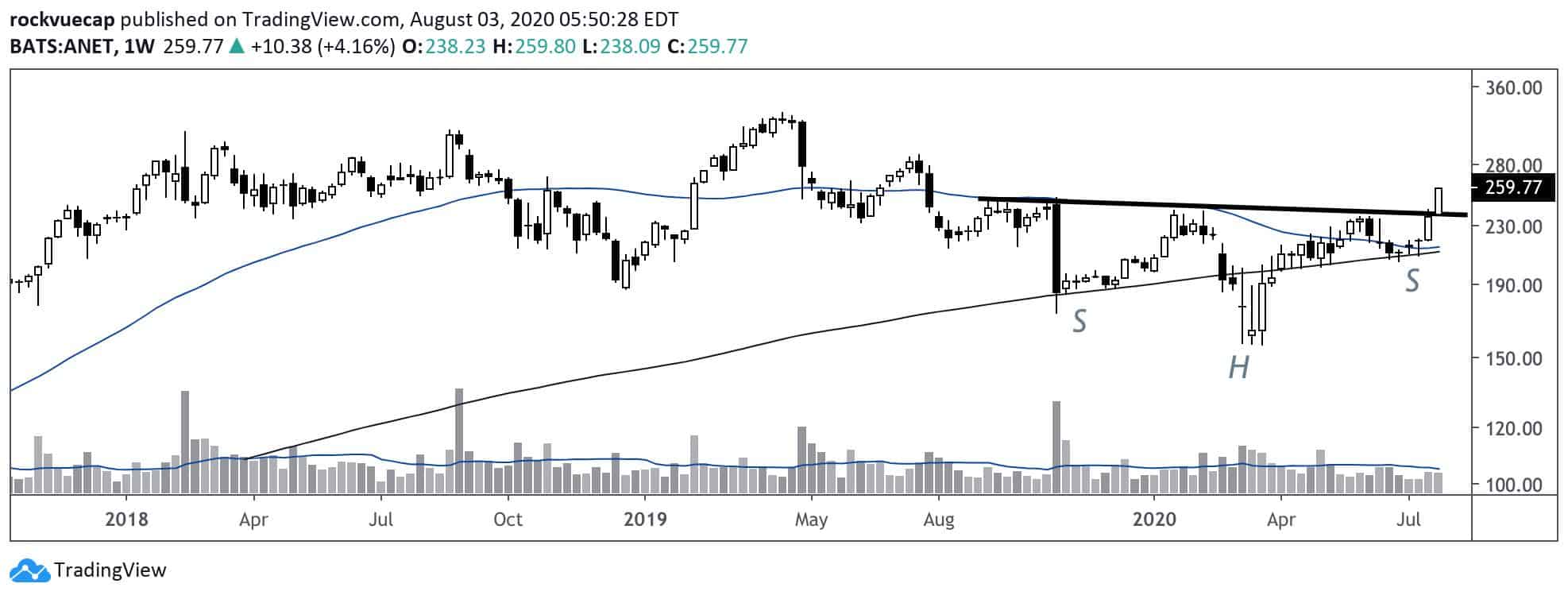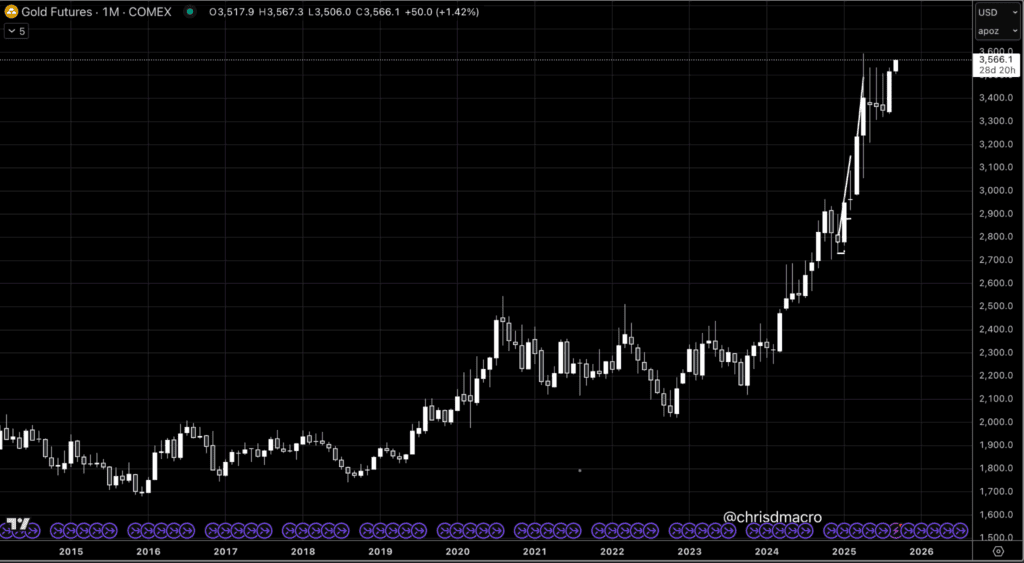Happy August! We hope you’re staying cool and your portfolio remains hot. We’re nearing the end of our Q2 letter analysis. After this week we’ll head back to more topical coverage of various investing related articles, videos and blogs.
In other house-keeping news, we’ve got a killer line-up of podcast guests this month. Can’t wait to bring you new episodes every week.
Our Latest Podcast Episodes:
Here’s the letters we cover this week:
-
- Alluvial Capital
- Greystone Capital
- Alta Fox Capital
We also feature a newsletter article on Costco (COST) business model and the latest Aswath Damodaran YouTube video.
Let’s dive in!
—
August 5th, 2020
Chart Of The Week: ANET completed an inverse H&S on the weekly chart last week. Breakout members were alerted to this trade a week before the breakout. The company has great qualities: net cash, growing revenues, expanding pre-tax margins and high ROIC.
The stock broke out above the 50MA and 200MA, giving us stronger belief in a newly-formed uptrend. We’ll see how prices follow through this week.
__________________________________________________________________________
Investor Spotlight: More & More Q2 Letters!
Many fund managers released their Q2 letters over the weekend. We’re profiling three this week. Let’s start with Laughing Water Capital.
Alluvial Capital: +14.80% Q2 2020
Dave Waters runs Alluvial Capital. If you don’t know who he is, check out my podcast with him here. I love Dave’s letters because he cuts right to what matters: the Fund’s holdings and investing-related concepts.
You can read his Q2 letter here.
Here’s Alluvial’s top five holdings:
1. P10 Holdings Inc: 15.4%
Dave’s Take: “I believe P10 shares are currently worth between $3.50 and $4.00, and potentially far more in future years depending on the company’s ability to acquire additional highmargin, predictable fee streams from alternative investments managers. COVID-19 has not slowed down P10’s ability to form relationships with new clients”
2. Intred S.p.A: 8.5%
Dave’s Take: “Shares have more than tripled since our initial purchases. This fiber-optic network operator continues to sign up new clients for its ultra-high-speed network, and recently acquired a competitor. The company is no longer an obvious value based on free cash flow yield, but Intred continues to enjoy a strong set of investment opportunities, both internal and external. What’s more, Intred has created a negative working capital cycle where it gets paid in advance for its services, effectively creating investment “float” and subsidizing its investment needs.”
3. Bredband2 i Skandinavien AB: 8.0%
Dave’s Take: “Unlike Intred, Bredband2 is largely non-asset-based, providing its services on networks owned by other parties. Like Intred, Bredband2 generates substantial cash from advance payments by customers. The magnitude of these payments allows Bredband2 to operate with negative invested capital and fund all its capex needs from customer pre-payments.”
4. LICT Corporation: 7.4%
Dave’s Take: “LICT is in prime position in the telecom industry. LICT has invested heavily over the years and now boasts a fiber-heavy, state-of-the-art network that is well-positioned to deliver broadband to rural Americans for decades to come. The company enjoys a substantial net cash position, enabling it to return virtually all its earnings to shareholders via share repurchases.”
5. Nuvera Communications 7.1%
Dave’s Take: “The company will benefit from increased need for quality consumer and business broadband connections in its Minnesota and Iowa service territories. I am hard-pressed to find a better combination of robust free cash flow generation, low risk operations and a healthy balance sheet. The company is not exactly exciting or communicative (despite the name) and perhaps that is why Nuvera shares languish at 8.3x free cash flow and 7.4x cash earnings (net income plus intangibles amortization).”
Negative Working Capital Analysis
Dave spends the rest of the letter discussing the power of negative working capital. For starters, working capital is current assets minus current liabilities. Here’s Dave explaining why a negative working capital model is attractive:
“For a firm that operates with negative working capital, growth actually provides a capital subsidy as additional cash rolls in. Instead of requiring incremental capital to support its working capital needs, the firm is free to use excess cash to subsidize investment in fixed assets, perform acquisitions, or return capital to shareholders without sacrificing growth opportunities.”
You can see the power of a negative WC cycle. It’s like an insurance business. Generate float. Reinvest the float before you make payments. But there’s a caveat: you need to grow to maintain the benefits.
I’ll let Dave explain (emphasis mine):
“If revenues fall, working capital consumes cash rather than providing it. The long-term benefits of a negative working capital model only accrue to companies offering products and services that will experience long-term growth in demand with minimal cyclicality.”
Greystone Capital Management: -5.1% Median 1H 2020
Adam Wilk runs Greystone Capital Management. The firm officially launched this year. Adam’s blog Pound the Rock Investing is one of my favorite reads. I’m stoked to see him launch his firm.
You can read his 1H 2020 letter here.
Alright, let’s get to his ideas.
CRH Medical Corp (CRH): -32% YTD
Business Description: “CRH Medical Corporation provides various products and services to gastroenterologists in the United States and Canada. It offers CRH O’Regan system, a single use, disposable, and hemorrhoid banding technology for treating various grades of hemorrhoid. The company also offers anesthesia services for patients undergoing endoscopic procedures.” – TIKR.com
Adam’s Take: “CRHM is now a $120mm market cap business that is set to generate $25-$40mm in free cash flow per year over the next several years growing at a high single digit rate. With a new management team in place focused on growing a complementary segment of the business, increasing the pace and volume of acquisitions, and continuing to grow free cash flow per share, CRHM has the potential to double or triple from our current cost basis. While short term results will without a doubt be impacted by the length of the coronavirus quarantine, over the long-term we should see a return to normal activity levels followed by both free cash flow increasing as well as multiple expansion.”
Hill International (HIL): -54.1% YTD
Business Description: Hill International, Inc. provides project and construction management, and other consulting services primarily for the buildings, transportation, environmental, energy, and industrial markets. – TIKR.com
Adam’s Take: “Clearly, the market is not believing in the turnaround. The share price reflects a business in decline, assuming A/R and cash collection will be difficult, and new business will continue to decrease. I’d argue that once we return to some normalized business environment, investors should see the share price rebound in line with improved operating results. As a sanity check, HIL continues to win new business despite project deferments and the current difficult environment (this includes $30m in new bookings during one week of Q2 alone).”
RCI Hospitality (RICK) — New Position, -41% YTD
Business Description: RCI Hospitality Holdings, Inc., through its subsidiaries, engages in the hospitality and related businesses in the United States. It operates through Nightclubs, Bombshells, and Other segments. – TIKR.com
Adam’s Take: “As somewhat a combination of special situation (a few nonpermanent, fixable events have led to a sharp stock price decline) and good business, RICK should be able to continue to grow it’s earning power and free cash flow per share at a solid rate over time. RICK is a business that I’ve followed for a few years now, and the current price seems to represent a very favorable risk/reward provided the business can remain structurally intact throughout COVID-19 shut down, and the management team continues to run the same playbook they’ve been running for the past few years.”
APi Group (APG) — New Position, +32% YTD
Business Description: APi Group Corporation provides commercial life safety solutions and industrial specialty services. The company offers specialty contracting services and solutions to the energy industry focused on transmission and distribution in the United States and Canada; and industrial services, including the retrofit and upgrading of existing pipeline facilities. – TIKR.com
Adam’s Take: “APi has a differentiated business model (discussed a little more below) consisting of targeting service related work first (where each dollar of service work sold leads to leads to 3-4x more service dollars and ultimately relationship based new construction opportunities) that is not dependent on new facility construction activity given their focus on non-discretionary maintenance spend. As a result, a large portion of Safety Services revenue mix is recurring at 40% up from just 21% in 2008. Management has called this recurring revenue high margin business. This helps insulate APi from downturns and gives visibility into revenue/earnings. Furthermore, company filings mention Fire & Security end markets as acyclical.”
This isn’t the first time we’ve seen APG in an investor letter. In fact, the name’s becoming somewhat of a value-based hedge fund hotel.
Terravest Industries (TRRVF) — New Position, +19.3% YTD
Business Description: TerraVest Industries Inc., together with its subsidiaries, manufactures and sells goods and services to energy, agriculture, mining, and transportation markets in Canada and the United States. – TIKR.com
Adam’s Take: “Terravest is illiquid, (as a sub-$300mm market cap business with over 30% of the float owned by insiders), has no analyst coverage, and the management team has historically been unwilling to give earnings guidance or host conference calls. As a result, Terravest is right up my alley in terms of investment criteria I look for; a boring, underfollowed microcap operating a niche business with a phenomenal management team, trading at a cheap valuation. The above factors can occasionally invite mispricings, and despite shares being up over 200% since 2014, TRRVF still appears to be undervalued relative to its long-term potential and strong capital allocators at the helm”
Alta Fox Capital: +60.5% (Net) Q2 2020
Connor Haley runs Alta Fox Capital and is quickly becoming one of my favorite investors. I had the privilege of chatting with him on last week’s podcast (listen here). Connor crushed Q2, returning over 60% net of fees.
Since inception he’s returned an annualized 32.1% net of fees. Incredible results. Connor attributes these returns to structural advantages embedded in a smaller one-man shop:
-
- More nimble than the average fund: “Alta Fox has an investment committee of one and I was able to quickly exit our most vulnerable positions while simultaneously initiating and adding to long positions in which we had deep conviction.”
- Greater investable universe: “Far too many funds have ignored the “obvious winners” over the last 5+ years because they wanted to emphasize their “uniqueness” as a marketing point. I have 80%+ of my net worth invested in Alta Fox and I am going to invest where I see the greatest opportunities irrespective of any marketing narrative”
These are important advantages that individual investors have, regardless if they run a fund. Small individual investors can invest in areas that larger managers can’t touch. This gives you the edge over other market participants.
It’s not enough to fish where the fish are. You must find spots where no other fisherman will venture.
Alta Fox’s New Idea: Enlabs (NLAB)
Macro Ops Collective members are familiar with this name. We presented it to our members over a month ago. It’s nice to see Connor find the idea of equal value and quality.
Business Description: It offers entertainment through various products, including casino, live casino, betting, poker, and bingo under various brands. The company is also involved in the performance-based marketing activities; and delivering of sports results and technical solutions in the online gaming industry. – TIKR.com
Connor’s Take: “Enlabs trades at 7.5x what we believe are conservative estimates for 2023 earnings and an even more staggering 3.8x earnings ex-cash. We believe shares of Enlabs are conservatively worth 100%+ higher than current prices and that the company has several realistic call options that could lead to significantly greater upside over the next five years.”
There’s three reasons why Connor likes the NLAB investment (via letter):
-
- Online gambling in the Baltics is growing rapidly (20%+ per year) with a long runway for growth
- Enlabs is likely to enter new geographies with 5-10x the collective online gambling TAM of the Baltics
- [Alta Fox] is very bullish on the company’s recent purchase of a 29.9% stake in Global Gaming (GLOBAL SS)
You can read Connor’s full research report here.
__________________________________________________________________________
Newsletter of The Week: Costco & Cannibalization
Adam Keesling writes Napkin Math, a Substack newsletter that’s quickly becoming one of my favorite reads. His July 15th edition, How Costco Convinces Brands to Cannibalize Themselves, demonstrates the power of Costco’s business model.
Here’s the main idea according to Keesling: [Costco] gets the best manufacturers in the world — who already have products on Costco shelves — to make Kirkland products.
That’s insane.
But suppliers buy-in. Why? Suppliers generate a ton of sales through Costco. Costco knows it, and so do their suppliers. Keesling mentioned a reddit user who used to work for a major Costco supplier (emphasis mine):
“As a supplier, you jump on it, because the data is clear that it jacks your sales. Usually your product sits right next to theirs on the shelf. So the consumer has 2 choices. Yours, or yours (at slightly worse margin).
You can be assured that the Kirkland brand is always the best, because it literally is.”
It’s a great deal for the supplier — and the math backs it up. Keesling assumes that under normal circumstances, suppliers make 16% margins (after subtracting marketing/non-marketing expense).
Under the Kirkland supplier deal suppliers make 14% margins. But remember, they generate more sales. So how does Costco justify suppliers making Kirkland products? Simple. Suppliers save on marketing expense, which raises margins to slightly lower than their own branded products. Higher volumes make up for 200bps lost margin.
Everyone wins.
__________________________________________________________________________
YouTube Video of The Week: COVID Lessons For Investing/Business
Aswath Damodaran’s back with a video on COVID Lessons for Investing/Business. It’s one of his quicker videos (40 minutes). I plan on watching it this morning. I always get a little smarter after listening to Aswath.
He’s an excellent teacher. Still can’t believe his education is free.
__________________________________________________________________________
That’s all I got for this week. Shoot me an email if you come across something interesting this week at brandon@macro-ops.com.
Tell Your Friends!
Do you love Value Hive?
Tell your friends about us! The greatest compliment we can receive is a referral (although we do accept Chipotle burrito bowls).
Click here to receive The Value Hive Directly To Your Inbox!










